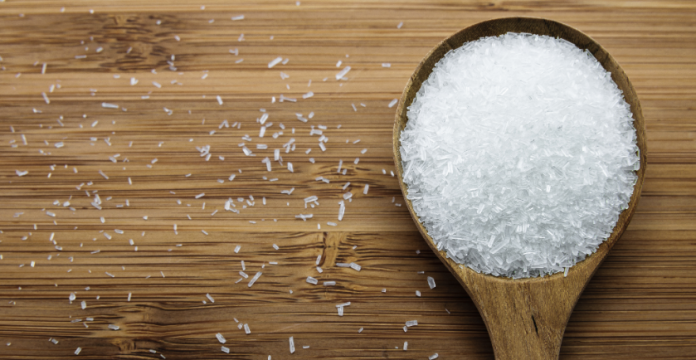
Monosodium glutamate (MSG) received much of its bad publicity because of its tendency to cause allergic reactions in certain people. However, MSG is actually available in two forms: the man-made variety that can trigger undesirable symptoms and which is added to a wide variety of processed food items, and the all-natural form that is found in a wide range of foods.
The MSG we know today was first produced by a Japanese food scientists named Kikunae Ikeda in 1908, who spearheaded the commercial development of this flavor enhancer. This synthetically derived ingredient is composed nearly entirely of glutamate and is very potent, which means it takes just a few drops to dramatically boost the flavor of whatever food to which it is added…so it’s easy to see why food producers and restaurant owners fell in love with MSG.
The term “glutamate” refers to various forms of glutamic acid, a non-essential amino acid that is among the most abundant ones found in nature. It is present in the human body as well as in many foods, such as seaweed, mushrooms, peas, and cheese. These and other foods are sources of natural glutamate, a substance that is primarily responsible for what is known as the “fifth taste”-aka umami.
Read about other names for MSG
We taste umami via taste receptors that are specific to glutamate. Because umami has highly specific receptors (unlike the other tastes of bitter, salty, sweet, and sour), it has been granted its own taste title.
Foods with free, naturally occurring glutamate
Natural glutamate can be found in foods as various forms of glutamic acid, with the greatest amounts appearing in kelp, seaweeds, maramite, and Vegemite, followed by fish sauce and soy sauce. Have you ever wondered why foods taste so much better sprinkled with parmesan cheese? A major reason could be because of its high levels of glutamate, the next food on this list, followed by Roquefort cheese, dried shiitake mushrooms, miso, green tea, anchovies, cured ham, sardines, cheddar cheese, tomatoes, and peas coming up behind.
Certain food ingredients, such as hydrolyzed protein and autolyzed yeast, contain significant levels of glutamates, but they are not the same as MSG. However, individuals who are sensitive to MSG can experience side effects that are similar or equal to those associated with the pure synthetic flavor enhancer.
MSG health effects
There’s a continuing controversy about the health effects of consuming MSG, sometimes referred to as the Chinese Restaurant Syndrome or, more scientifically, MSG symptom complex. At one time, many Asian restaurants (and others as well) were using MSG, but that practice has changed significantly over the years. Now it is not uncommon to see signage in restaurants saying that they do not use MSG.
Read more about MSG side effects
At its core, MSG is an excitotoxin, a substance capable of overstimulating your cells and causing cell damage or cell death. Dr. Joseph Mercola notes that an estimated 40 percent of the population may be intolerance to MSG at some level.
Side effects reported from use of MSG include headaches, flushing, sweating, facial tightness or pressure, heart palpitations, nausea, weakness, chest pain, and numbness, tingling, or burning in the face or other areas of the body.
According to Dr. Russell Blaylock, a board-certified neurosurgeon and author of "Excitotoxins: The Taste that Kills, excitotoxins such as MSG, hydrolyzed protein soy protein isolate and concentrate, natural flavoring, sodium caseinate and aspartate from aspartame” also can affect the heart, causing overstimulation of glutamate receptors and leading to cardiac arrhythmias. Regular consumption of MSG also has been associated with obesity, depression, eye damage, and disorientation.
Bottom line
The synthetic food additive known as MSG is not a healthy choice for anyone, even if consuming the substance does not cause symptoms. Read food labels carefully, and even if you don’t see the words “monosodium glutamate” or MSG, there are other substances that have high levels of synthetic glutamates, such as calcium caseinate, sodium caseinate, textured protein, yeast extract, monopotassium glutamate, and gelatin. The best way to avoid MSG is to choose whole, natural foods, avoid processed products, and read labels.
[Editor's Note: Our favorite umami sauce comes from San-J. Their Organic Tamari Reduced Sodium contains organic soy, is non-GMO, and gluten free. With simple ingredients of water, organic soybeans, salt, and organic alcohol, and brewed through a natural fermentation process, the sauce only contains naturally occurring MSG. No artificial or chemical ingredients that could make you feel unwell.]
References
Dickson J. Myths and misconceptions: MSG. Whole Foods. 2008 Jul 28
Food Standards Australia New Zealand. Monosodium glutamate: a safety assessment June 2003
Lubin G. Business Insider. These magical foods are loaded with natural MSG. 2017 Feb 3
Mercola J. MSG: Is this silent killer lurking in your kitchen cabinets. 2009 April 21
Zeratsy K. What is MSG? Is it bad for you? Mayo Clinic




